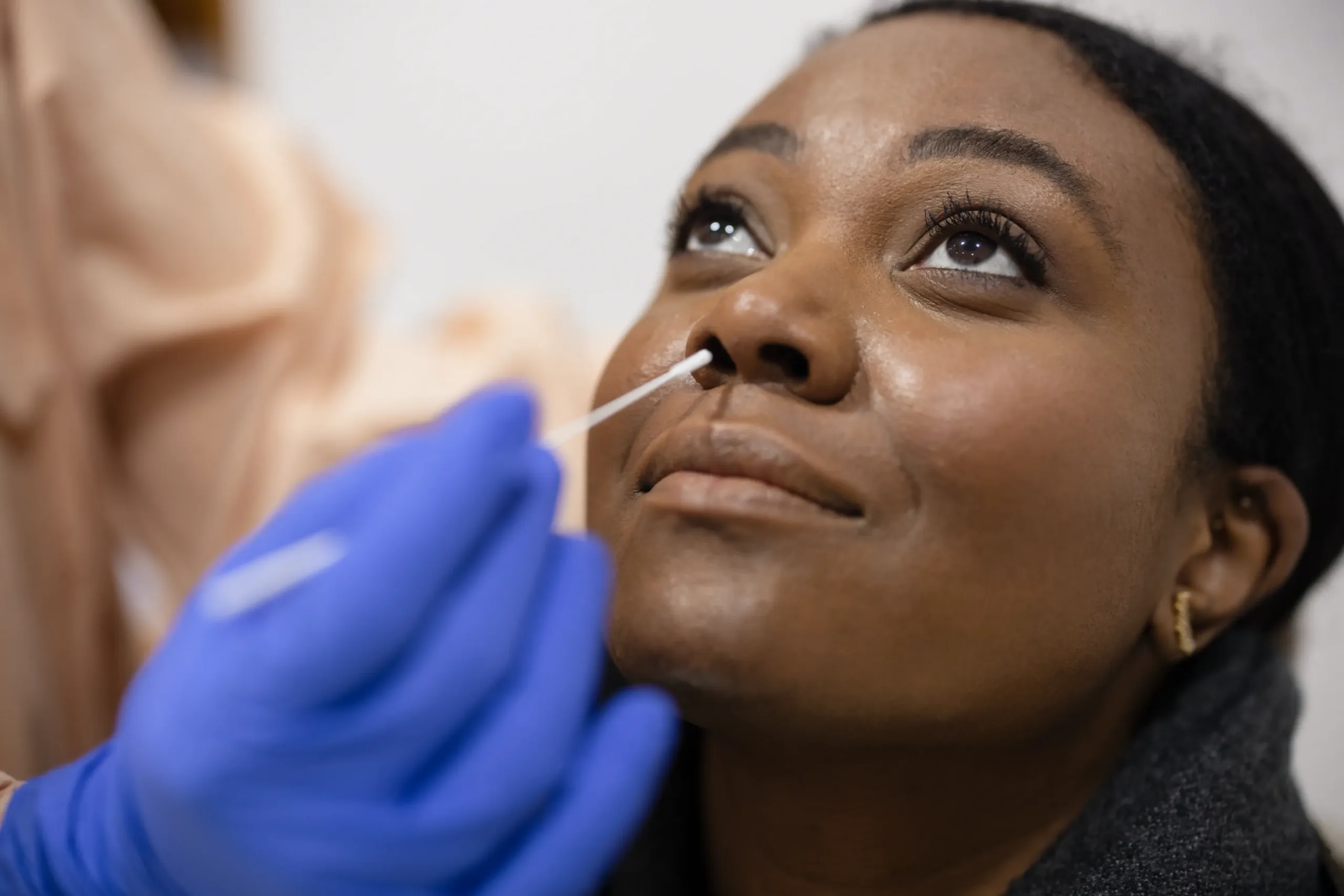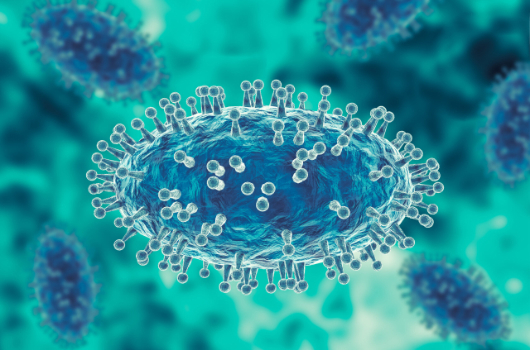Clinical Study
Respiratory Infections – Understanding the Seasonal Patterns

HealthTrackRx • July 18, 2024
Infectious diseases exhibit distinct seasonal patterns, greatly influencing public health strategies and medical preparedness. Among these seasonal patterns, respiratory season stands out for its significant impact during specific times of the year. This article details the seasonality of more prominent respiratory infections, providing insights into their patterns and the implications for healthcare systems.
Seasonal Patterns of Respiratory Infections
Respiratory infections, including influenza, respiratory syncytial virus (RSV), and, more recently, COVID-19, are markedly seasonal, peaking during the colder months. The seasonality of these infections can be attributed to a combination of environmental, host, and viral factors.
Influenza
Influenza, commonly known as the flu, exhibits a well-documented seasonality, with cases surging in winter. In the US, flu season typically spans from October to March. According to the Centers for Disease Control and Prevention (CDC), the US experiences an average of 35 million flu cases annually, resulting in approximately 34,000 deaths during a typical flu season (1).
Several factors contribute to the winter peak of influenza:
Respiratory Syncytial Virus (RSV)
RSV is another prominent respiratory virus that follows a seasonal pattern, with peak activity typically occurring from late fall to early spring. RSV is a leading cause of respiratory infections in young children and can cause severe illnesses in infants and older adults. The CDC reports that RSV leads to about 58,000 hospitalizations and 100–500 deaths annually among children under five in the United States (5).
Like influenza, factors influencing RSV’s seasonality include environmental conditions and increased indoor activity during colder months.
COVID-19
COVID-19 has displayed some seasonal trends, although its behavior is more complex due to factors such as vaccination campaigns, new variants, and varying public health measures. Initial studies indicated that COVID-19 transmission might be higher during winter, like other respiratory viruses. For example, a study published in Nature Communications found that COVID-19 cases surged in regions with colder climates during the pandemic’s early phases (6).
The seasonality of COVID-19 is influenced by similar factors to those affecting influenza and RSV, including environmental conditions and increased indoor activity during colder months.
While similar factors, including environmental conditions and changes in behavior, are believed to affect the seasonality of all respiratory viruses, it’s unclear why these pathogens don’t display the same circulation patterns. As such, more work remains to better understand their seasonality.
Impact of Seasonality on Healthcare
The seasonal peaks of respiratory infections place a considerable strain on healthcare systems. Hospitals often face surges in admissions, and emergency departments experience increased patient volumes during the winter months. This requires planning in advance and properly allocating resources to effectively manage the surge of cases.
Public health initiatives, such as vaccination campaigns, are timed to precede the onset of the respiratory infection season. For instance, annual flu vaccinations are recommended starting in October to protect individuals before the flu season peaks (7).
Efforts to mitigate the impact of seasonal respiratory infections include:
Conclusion
The seasonality of respiratory infections underscores the importance of timely public health interventions and healthcare preparedness. Understanding the factors driving these seasonal patterns enables more effective prevention, diagnostic testing, and management strategies, ultimately reducing the burden of these infections on individuals and healthcare systems. As we continue to navigate the challenges posed by seasonal respiratory infections, ongoing research on the diseases and the development of tools to combat and prevent infections are essential to adapt and enhance our response efforts.
References
- Centers for Disease Control and Prevention (CDC). “Influenza (Flu).”
CDC Flu Information - Tamerius, J. D., et al. “Environmental Predictors of Seasonal Influenza Epidemics across Temperate and Tropical Climates.”
PLOS Pathogens, 2013. - Lofgren, E., et al. “Influenza Seasonality: Underlying Causes and Modeling Theories.”
Journal of Virology, 2007. - Cannell, J. J., et al. “Epidemic Influenza and Vitamin D.”
Epidemiology and Infection, 2006. - Centers for Disease Control and Prevention (CDC). “Respiratory Syncytial Virus (RSV).”
CDC RSV Information
- Landier, J., Paireau, J., Rebaudet, S., et al. “Cold and dry winter conditions are associated with greater SARS-CoV-2 transmission at regional level in western countries during the first epidemic wave.”
Scientific Reports, 2021.
https://doi.org/10.1038/s41598-021-91798-9 - Eccles, R. “An Explanation for the Seasonality of Acute Upper Respiratory Tract Viral Infections.”
Acta Otolaryngologica, 2002. - Centers for Disease Control and Prevention (CDC). “Flu Vaccination Coverage, United States, 2019–20 Influenza Season.”
CDC Flu Vaccine Coverage
References
- Centers for Disease Control and Prevention (CDC). “Influenza (Flu).”
CDC Flu Information - Tamerius, J. D., et al. “Environmental Predictors of Seasonal Influenza Epidemics across Temperate and Tropical Climates.”
PLOS Pathogens, 2013. - Lofgren, E., et al. “Influenza Seasonality: Underlying Causes and Modeling Theories.”
Journal of Virology, 2007. - Cannell, J. J., et al. “Epidemic Influenza and Vitamin D.”
Epidemiology and Infection, 2006. - Centers for Disease Control and Prevention (CDC). “Respiratory Syncytial Virus (RSV).”
CDC RSV Information - Landier, J., Paireau, J., Rebaudet, S., et al. “Cold and dry winter conditions are associated with greater SARS-CoV-2 transmission at regional level in western countries during the first epidemic wave.”
Scientific Reports, 2021.
https://doi.org/10.1038/s41598-021-91798-9 - Eccles, R. “An Explanation for the Seasonality of Acute Upper Respiratory Tract Viral Infections.”
Acta Otolaryngologica, 2002. - Centers for Disease Control and Prevention (CDC). “Flu Vaccination Coverage, United States, 2019–20 Influenza Season.”
CDC Flu Vaccine Coverage
Related Articles and White papers

HealthTrackRx • July 18, 2024
Infectious diseases exhibit distinct seasonal patterns, greatly influencing public health strategies and medical preparedness. Among these seasonal patterns, respiratory season stands out for its significant impact during specific times of the year. This article details the seasonality of more prominent respiratory infections, providing insights into their patterns and the implications for healthcare systems.
Seasonal Patterns of Respiratory Infections
Respiratory infections, including influenza, respiratory syncytial virus (RSV), and, more recently, COVID-19, are markedly seasonal, peaking during the colder months. The seasonality of these infections can be attributed to a combination of environmental, host, and viral factors.
Influenza
Influenza, commonly known as the flu, exhibits a well-documented seasonality, with cases surging in winter. In the US, flu season typically spans from October to March. According to the Centers for Disease Control and Prevention (CDC), the US experiences an average of 35 million flu cases annually, resulting in approximately 34,000 deaths during a typical flu season (1).
Several factors contribute to the winter peak of influenza:
Respiratory Syncytial Virus (RSV)
RSV is another prominent respiratory virus that follows a seasonal pattern, with peak activity typically occurring from late fall to early spring. RSV is a leading cause of respiratory infections in young children and can cause severe illnesses in infants and older adults. The CDC reports that RSV leads to about 58,000 hospitalizations and 100–500 deaths annually among children under five in the United States (5).
Like influenza, factors influencing RSV’s seasonality include environmental conditions and increased indoor activity during colder months.
COVID-19
COVID-19 has displayed some seasonal trends, although its behavior is more complex due to factors such as vaccination campaigns, new variants, and varying public health measures. Initial studies indicated that COVID-19 transmission might be higher during winter, like other respiratory viruses. For example, a study published in Nature Communications found that COVID-19 cases surged in regions with colder climates during the pandemic’s early phases (6).
The seasonality of COVID-19 is influenced by similar factors to those affecting influenza and RSV, including environmental conditions and increased indoor activity during colder months.
While similar factors, including environmental conditions and changes in behavior, are believed to affect the seasonality of all respiratory viruses, it’s unclear why these pathogens don’t display the same circulation patterns. As such, more work remains to better understand their seasonality.
Impact of Seasonality on Healthcare
The seasonal peaks of respiratory infections place a considerable strain on healthcare systems. Hospitals often face surges in admissions, and emergency departments experience increased patient volumes during the winter months. This requires planning in advance and properly allocating resources to effectively manage the surge of cases.
Public health initiatives, such as vaccination campaigns, are timed to precede the onset of the respiratory infection season. For instance, annual flu vaccinations are recommended starting in October to protect individuals before the flu season peaks (7).
Efforts to mitigate the impact of seasonal respiratory infections include:
Conclusion
The seasonality of respiratory infections underscores the importance of timely public health interventions and healthcare preparedness. Understanding the factors driving these seasonal patterns enables more effective prevention, diagnostic testing, and management strategies, ultimately reducing the burden of these infections on individuals and healthcare systems. As we continue to navigate the challenges posed by seasonal respiratory infections, ongoing research on the diseases and the development of tools to combat and prevent infections are essential to adapt and enhance our response efforts.
References
- Centers for Disease Control and Prevention (CDC). “Influenza (Flu).”
CDC Flu Information - Tamerius, J. D., et al. “Environmental Predictors of Seasonal Influenza Epidemics across Temperate and Tropical Climates.”
PLOS Pathogens, 2013. - Lofgren, E., et al. “Influenza Seasonality: Underlying Causes and Modeling Theories.”
Journal of Virology, 2007. - Cannell, J. J., et al. “Epidemic Influenza and Vitamin D.”
Epidemiology and Infection, 2006. - Centers for Disease Control and Prevention (CDC). “Respiratory Syncytial Virus (RSV).”
CDC RSV Information
- Landier, J., Paireau, J., Rebaudet, S., et al. “Cold and dry winter conditions are associated with greater SARS-CoV-2 transmission at regional level in western countries during the first epidemic wave.”
Scientific Reports, 2021.
https://doi.org/10.1038/s41598-021-91798-9 - Eccles, R. “An Explanation for the Seasonality of Acute Upper Respiratory Tract Viral Infections.”
Acta Otolaryngologica, 2002. - Centers for Disease Control and Prevention (CDC). “Flu Vaccination Coverage, United States, 2019–20 Influenza Season.”
CDC Flu Vaccine Coverage
References
- Centers for Disease Control and Prevention (CDC). “Influenza (Flu).”
CDC Flu Information - Tamerius, J. D., et al. “Environmental Predictors of Seasonal Influenza Epidemics across Temperate and Tropical Climates.”
PLOS Pathogens, 2013. - Lofgren, E., et al. “Influenza Seasonality: Underlying Causes and Modeling Theories.”
Journal of Virology, 2007. - Cannell, J. J., et al. “Epidemic Influenza and Vitamin D.”
Epidemiology and Infection, 2006. - Centers for Disease Control and Prevention (CDC). “Respiratory Syncytial Virus (RSV).”
CDC RSV Information - Landier, J., Paireau, J., Rebaudet, S., et al. “Cold and dry winter conditions are associated with greater SARS-CoV-2 transmission at regional level in western countries during the first epidemic wave.”
Scientific Reports, 2021.
https://doi.org/10.1038/s41598-021-91798-9 - Eccles, R. “An Explanation for the Seasonality of Acute Upper Respiratory Tract Viral Infections.”
Acta Otolaryngologica, 2002. - Centers for Disease Control and Prevention (CDC). “Flu Vaccination Coverage, United States, 2019–20 Influenza Season.”
CDC Flu Vaccine Coverage





